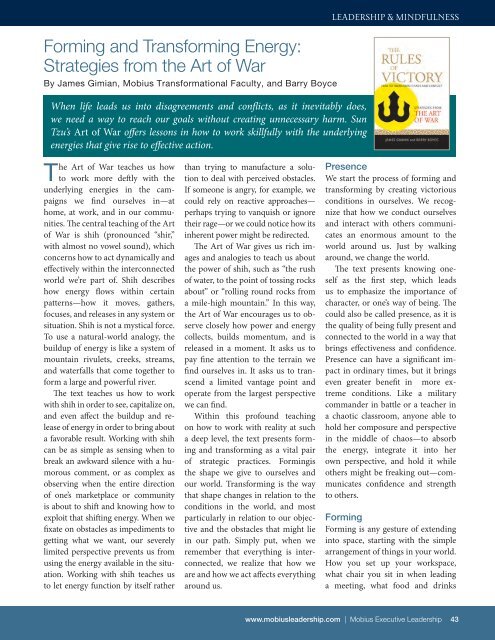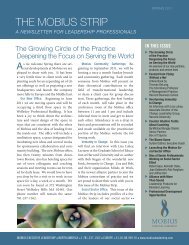Leadership & Mindfulness - Mobius Executive Leadership
Leadership & Mindfulness - Mobius Executive Leadership
Leadership & Mindfulness - Mobius Executive Leadership
You also want an ePaper? Increase the reach of your titles
YUMPU automatically turns print PDFs into web optimized ePapers that Google loves.
Forming and Transforming Energy:Strategies from the Art of WarBy James Gimian, <strong>Mobius</strong> Transformational Faculty, and Barry BoyceWhen life leads us into disagreements and conflicts, as it inevitably does,we need a way to reach our goals without creating unnecessary harm. SunTzu’s Art of War offers lessons in how to work skillfully with the underlyingenergies that give rise to effective action.The Art of War teaches us howto work more deftly with theunderlying energies in the campaignswe find ourselves in—athome, at work, and in our communities.The central teaching of the Artof War is shih (pronounced “shir,”with almost no vowel sound), whichconcerns how to act dynamically andeffectively within the interconnectedworld we’re part of. Shih describeshow energy flows within certainpatterns—how it moves, gathers,focuses, and releases in any system orsituation. Shih is not a mystical force.To use a natural-world analogy, thebuildup of energy is like a system ofmountain rivulets, creeks, streams,and waterfalls that come together toform a large and powerful river.The text teaches us how to workwith shih in order to see, capitalize on,and even affect the buildup and releaseof energy in order to bring abouta favorable result. Working with shihcan be as simple as sensing when tobreak an awkward silence with a humorouscomment, or as complex asobserving when the entire directionof one’s marketplace or communityis about to shift and knowing how toexploit that shifting energy. When wefixate on obstacles as impediments togetting what we want, our severelylimited perspective prevents us fromusing the energy available in the situation.Working with shih teaches usto let energy function by itself ratherthan trying to manufacture a solutionto deal with perceived obstacles.If someone is angry, for example, wecould rely on reactive approaches—perhaps trying to vanquish or ignoretheir rage—or we could notice how itsinherent power might be redirected.The Art of War gives us rich imagesand analogies to teach us aboutthe power of shih, such as “the rushof water, to the point of tossing rocksabout” or “rolling round rocks froma mile-high mountain.” In this way,the Art of War encourages us to observeclosely how power and energycollects, builds momentum, and isreleased in a moment. It asks us topay fine attention to the terrain wefind ourselves in. It asks us to transcenda limited vantage point andoperate from the largest perspectivewe can find.Within this profound teachingon how to work with reality at sucha deep level, the text presents formingand transforming as a vital pairof strategic practices. Formingisthe shape we give to ourselves andour world. Transforming is the waythat shape changes in relation to theconditions in the world, and mostparticularly in relation to our objectiveand the obstacles that might liein our path. Simply put, when weremember that everything is interconnected,we realize that how weare and how we act affects everythingaround us.LEADERSHIP & <strong>Mindfulness</strong>PresenceWe start the process of forming andtransforming by creating victoriousconditions in ourselves. We recognizethat how we conduct ourselvesand interact with others communicatesan enormous amount to theworld around us. Just by walkingaround, we change the world.The text presents knowing oneselfas the first step, which leadsus to emphasize the importance ofcharacter, or one’s way of being. Thecould also be called presence, as it isthe quality of being fully present andconnected to the world in a way thatbrings effectiveness and confidence.Presence can have a significant impactin ordinary times, but it bringseven greater benefit in more extremeconditions. Like a militarycommander in battle or a teacher ina chaotic classroom, anyone able tohold her composure and perspectivein the middle of chaos—to absorbthe energy, integrate it into herown perspective, and hold it whileothers might be freaking out—communicatesconfidence and strengthto others.FormingForming is any gesture of extendinginto space, starting with the simplearrangement of things in your world.How you set up your workspace,what chair you sit in when leadinga meeting, what food and drinkswww.mobiusleadership.com | <strong>Mobius</strong> <strong>Executive</strong> <strong>Leadership</strong> 43



